Better Placed: An Integrated Policy
VerifiedAdded on 2023/03/17
|6
|3277
|99
AI Summary
This article discusses the Better Placed policy in NSW and its role in improving the design of cities, towns, and suburbs. It explores the strategies and expected results of the policy, as well as its impact on the NSW planning system.
Contribute Materials
Your contribution can guide someone’s learning journey. Share your
documents today.
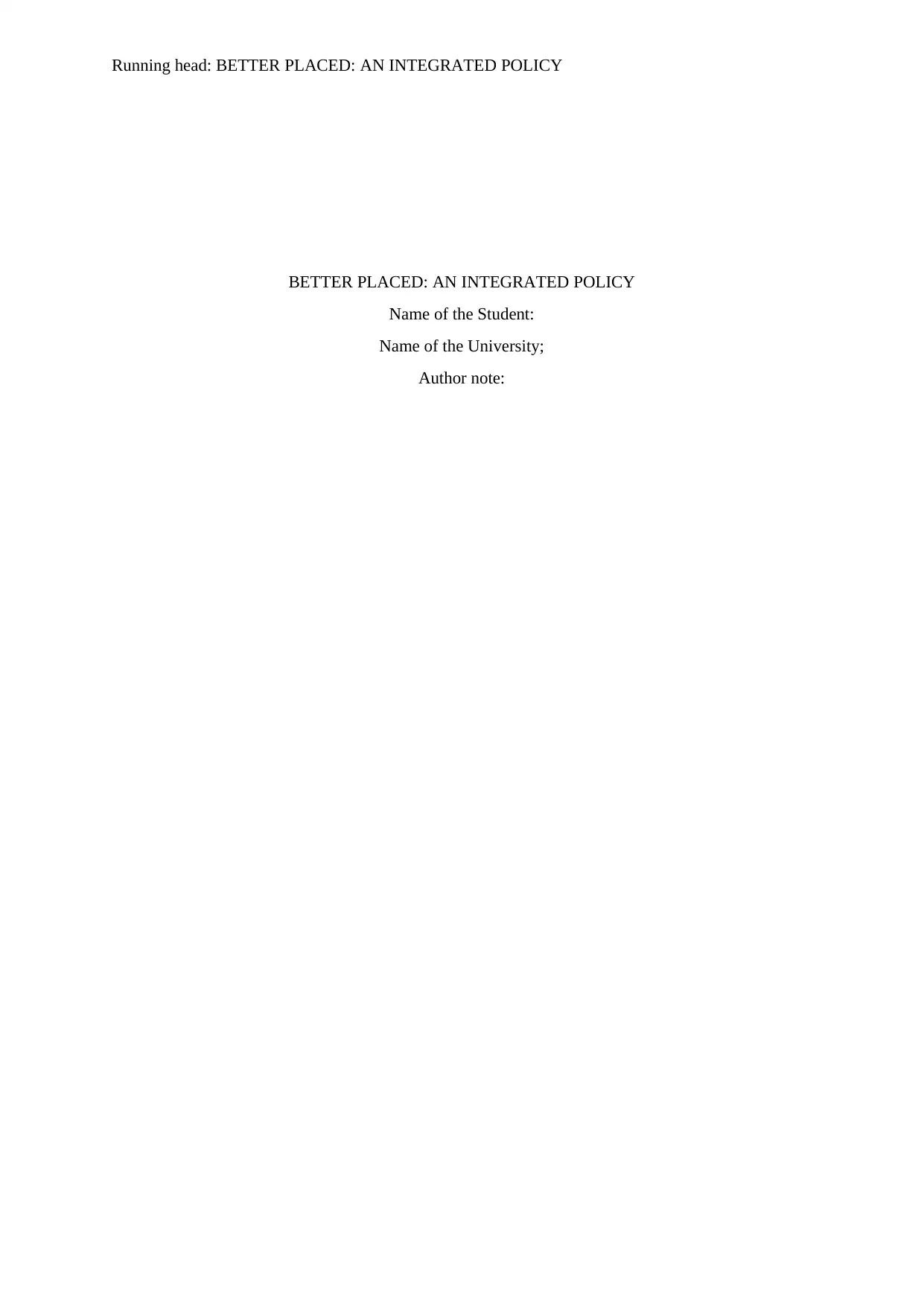
Running head: BETTER PLACED: AN INTEGRATED POLICY
BETTER PLACED: AN INTEGRATED POLICY
Name of the Student:
Name of the University;
Author note:
BETTER PLACED: AN INTEGRATED POLICY
Name of the Student:
Name of the University;
Author note:
Secure Best Marks with AI Grader
Need help grading? Try our AI Grader for instant feedback on your assignments.
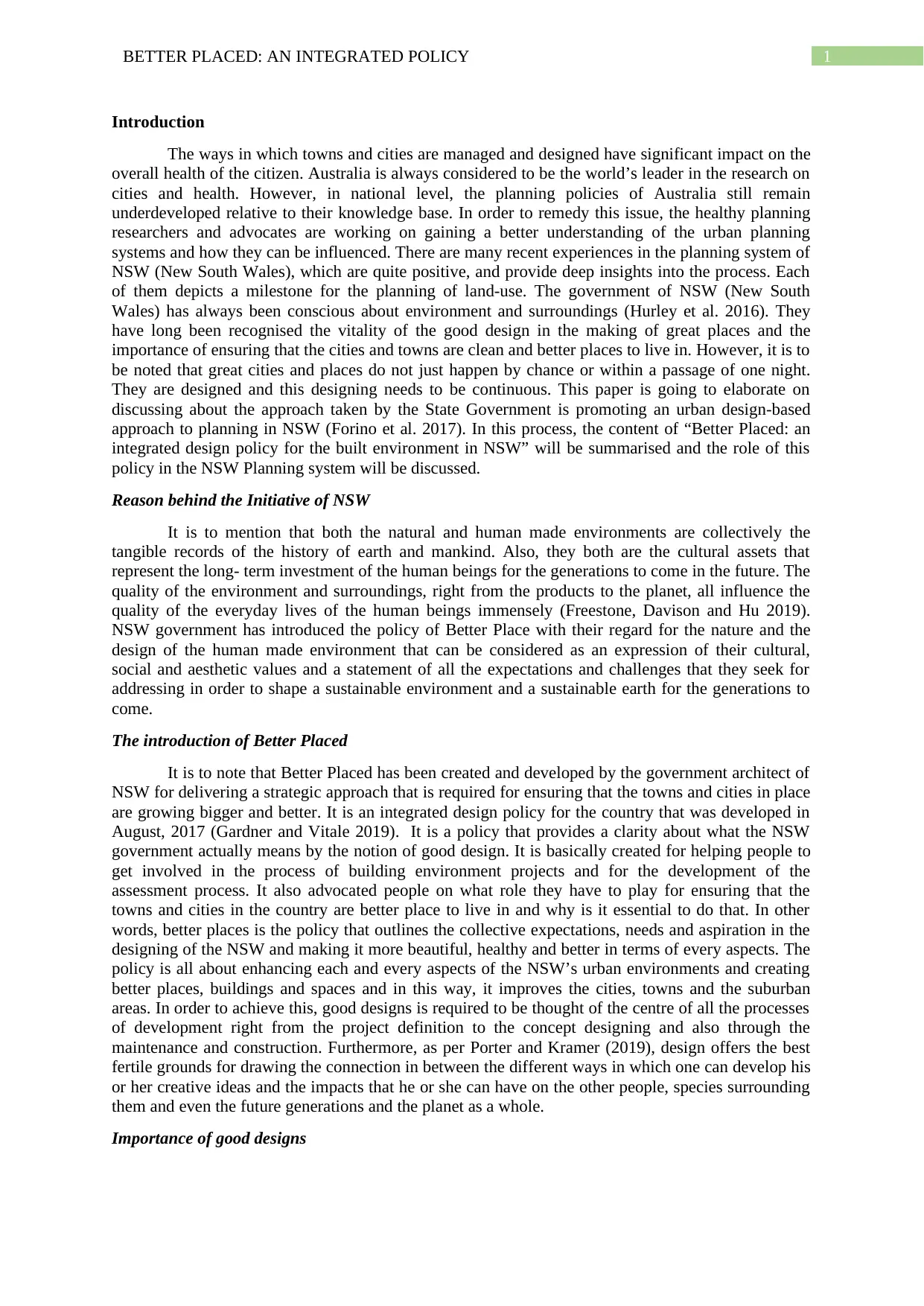
1BETTER PLACED: AN INTEGRATED POLICY
Introduction
The ways in which towns and cities are managed and designed have significant impact on the
overall health of the citizen. Australia is always considered to be the world’s leader in the research on
cities and health. However, in national level, the planning policies of Australia still remain
underdeveloped relative to their knowledge base. In order to remedy this issue, the healthy planning
researchers and advocates are working on gaining a better understanding of the urban planning
systems and how they can be influenced. There are many recent experiences in the planning system of
NSW (New South Wales), which are quite positive, and provide deep insights into the process. Each
of them depicts a milestone for the planning of land-use. The government of NSW (New South
Wales) has always been conscious about environment and surroundings (Hurley et al. 2016). They
have long been recognised the vitality of the good design in the making of great places and the
importance of ensuring that the cities and towns are clean and better places to live in. However, it is to
be noted that great cities and places do not just happen by chance or within a passage of one night.
They are designed and this designing needs to be continuous. This paper is going to elaborate on
discussing about the approach taken by the State Government is promoting an urban design-based
approach to planning in NSW (Forino et al. 2017). In this process, the content of “Better Placed: an
integrated design policy for the built environment in NSW” will be summarised and the role of this
policy in the NSW Planning system will be discussed.
Reason behind the Initiative of NSW
It is to mention that both the natural and human made environments are collectively the
tangible records of the history of earth and mankind. Also, they both are the cultural assets that
represent the long- term investment of the human beings for the generations to come in the future. The
quality of the environment and surroundings, right from the products to the planet, all influence the
quality of the everyday lives of the human beings immensely (Freestone, Davison and Hu 2019).
NSW government has introduced the policy of Better Place with their regard for the nature and the
design of the human made environment that can be considered as an expression of their cultural,
social and aesthetic values and a statement of all the expectations and challenges that they seek for
addressing in order to shape a sustainable environment and a sustainable earth for the generations to
come.
The introduction of Better Placed
It is to note that Better Placed has been created and developed by the government architect of
NSW for delivering a strategic approach that is required for ensuring that the towns and cities in place
are growing bigger and better. It is an integrated design policy for the country that was developed in
August, 2017 (Gardner and Vitale 2019). It is a policy that provides a clarity about what the NSW
government actually means by the notion of good design. It is basically created for helping people to
get involved in the process of building environment projects and for the development of the
assessment process. It also advocated people on what role they have to play for ensuring that the
towns and cities in the country are better place to live in and why is it essential to do that. In other
words, better places is the policy that outlines the collective expectations, needs and aspiration in the
designing of the NSW and making it more beautiful, healthy and better in terms of every aspects. The
policy is all about enhancing each and every aspects of the NSW’s urban environments and creating
better places, buildings and spaces and in this way, it improves the cities, towns and the suburban
areas. In order to achieve this, good designs is required to be thought of the centre of all the processes
of development right from the project definition to the concept designing and also through the
maintenance and construction. Furthermore, as per Porter and Kramer (2019), design offers the best
fertile grounds for drawing the connection in between the different ways in which one can develop his
or her creative ideas and the impacts that he or she can have on the other people, species surrounding
them and even the future generations and the planet as a whole.
Importance of good designs
Introduction
The ways in which towns and cities are managed and designed have significant impact on the
overall health of the citizen. Australia is always considered to be the world’s leader in the research on
cities and health. However, in national level, the planning policies of Australia still remain
underdeveloped relative to their knowledge base. In order to remedy this issue, the healthy planning
researchers and advocates are working on gaining a better understanding of the urban planning
systems and how they can be influenced. There are many recent experiences in the planning system of
NSW (New South Wales), which are quite positive, and provide deep insights into the process. Each
of them depicts a milestone for the planning of land-use. The government of NSW (New South
Wales) has always been conscious about environment and surroundings (Hurley et al. 2016). They
have long been recognised the vitality of the good design in the making of great places and the
importance of ensuring that the cities and towns are clean and better places to live in. However, it is to
be noted that great cities and places do not just happen by chance or within a passage of one night.
They are designed and this designing needs to be continuous. This paper is going to elaborate on
discussing about the approach taken by the State Government is promoting an urban design-based
approach to planning in NSW (Forino et al. 2017). In this process, the content of “Better Placed: an
integrated design policy for the built environment in NSW” will be summarised and the role of this
policy in the NSW Planning system will be discussed.
Reason behind the Initiative of NSW
It is to mention that both the natural and human made environments are collectively the
tangible records of the history of earth and mankind. Also, they both are the cultural assets that
represent the long- term investment of the human beings for the generations to come in the future. The
quality of the environment and surroundings, right from the products to the planet, all influence the
quality of the everyday lives of the human beings immensely (Freestone, Davison and Hu 2019).
NSW government has introduced the policy of Better Place with their regard for the nature and the
design of the human made environment that can be considered as an expression of their cultural,
social and aesthetic values and a statement of all the expectations and challenges that they seek for
addressing in order to shape a sustainable environment and a sustainable earth for the generations to
come.
The introduction of Better Placed
It is to note that Better Placed has been created and developed by the government architect of
NSW for delivering a strategic approach that is required for ensuring that the towns and cities in place
are growing bigger and better. It is an integrated design policy for the country that was developed in
August, 2017 (Gardner and Vitale 2019). It is a policy that provides a clarity about what the NSW
government actually means by the notion of good design. It is basically created for helping people to
get involved in the process of building environment projects and for the development of the
assessment process. It also advocated people on what role they have to play for ensuring that the
towns and cities in the country are better place to live in and why is it essential to do that. In other
words, better places is the policy that outlines the collective expectations, needs and aspiration in the
designing of the NSW and making it more beautiful, healthy and better in terms of every aspects. The
policy is all about enhancing each and every aspects of the NSW’s urban environments and creating
better places, buildings and spaces and in this way, it improves the cities, towns and the suburban
areas. In order to achieve this, good designs is required to be thought of the centre of all the processes
of development right from the project definition to the concept designing and also through the
maintenance and construction. Furthermore, as per Porter and Kramer (2019), design offers the best
fertile grounds for drawing the connection in between the different ways in which one can develop his
or her creative ideas and the impacts that he or she can have on the other people, species surrounding
them and even the future generations and the planet as a whole.
Importance of good designs
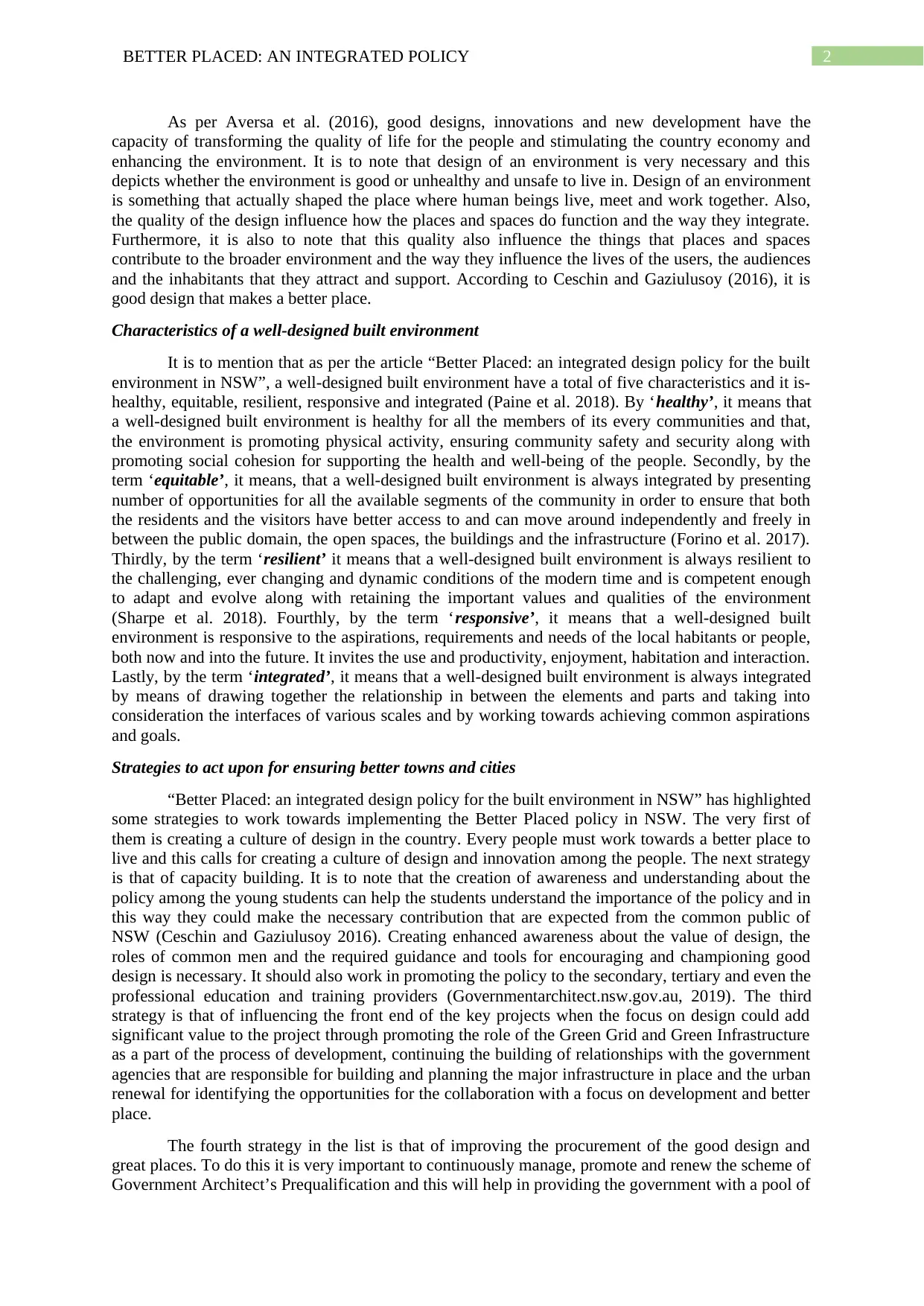
2BETTER PLACED: AN INTEGRATED POLICY
As per Aversa et al. (2016), good designs, innovations and new development have the
capacity of transforming the quality of life for the people and stimulating the country economy and
enhancing the environment. It is to note that design of an environment is very necessary and this
depicts whether the environment is good or unhealthy and unsafe to live in. Design of an environment
is something that actually shaped the place where human beings live, meet and work together. Also,
the quality of the design influence how the places and spaces do function and the way they integrate.
Furthermore, it is also to note that this quality also influence the things that places and spaces
contribute to the broader environment and the way they influence the lives of the users, the audiences
and the inhabitants that they attract and support. According to Ceschin and Gaziulusoy (2016), it is
good design that makes a better place.
Characteristics of a well-designed built environment
It is to mention that as per the article “Better Placed: an integrated design policy for the built
environment in NSW”, a well-designed built environment have a total of five characteristics and it is-
healthy, equitable, resilient, responsive and integrated (Paine et al. 2018). By ‘healthy’, it means that
a well-designed built environment is healthy for all the members of its every communities and that,
the environment is promoting physical activity, ensuring community safety and security along with
promoting social cohesion for supporting the health and well-being of the people. Secondly, by the
term ‘equitable’, it means, that a well-designed built environment is always integrated by presenting
number of opportunities for all the available segments of the community in order to ensure that both
the residents and the visitors have better access to and can move around independently and freely in
between the public domain, the open spaces, the buildings and the infrastructure (Forino et al. 2017).
Thirdly, by the term ‘resilient’ it means that a well-designed built environment is always resilient to
the challenging, ever changing and dynamic conditions of the modern time and is competent enough
to adapt and evolve along with retaining the important values and qualities of the environment
(Sharpe et al. 2018). Fourthly, by the term ‘responsive’, it means that a well-designed built
environment is responsive to the aspirations, requirements and needs of the local habitants or people,
both now and into the future. It invites the use and productivity, enjoyment, habitation and interaction.
Lastly, by the term ‘integrated’, it means that a well-designed built environment is always integrated
by means of drawing together the relationship in between the elements and parts and taking into
consideration the interfaces of various scales and by working towards achieving common aspirations
and goals.
Strategies to act upon for ensuring better towns and cities
“Better Placed: an integrated design policy for the built environment in NSW” has highlighted
some strategies to work towards implementing the Better Placed policy in NSW. The very first of
them is creating a culture of design in the country. Every people must work towards a better place to
live and this calls for creating a culture of design and innovation among the people. The next strategy
is that of capacity building. It is to note that the creation of awareness and understanding about the
policy among the young students can help the students understand the importance of the policy and in
this way they could make the necessary contribution that are expected from the common public of
NSW (Ceschin and Gaziulusoy 2016). Creating enhanced awareness about the value of design, the
roles of common men and the required guidance and tools for encouraging and championing good
design is necessary. It should also work in promoting the policy to the secondary, tertiary and even the
professional education and training providers (Governmentarchitect.nsw.gov.au, 2019). The third
strategy is that of influencing the front end of the key projects when the focus on design could add
significant value to the project through promoting the role of the Green Grid and Green Infrastructure
as a part of the process of development, continuing the building of relationships with the government
agencies that are responsible for building and planning the major infrastructure in place and the urban
renewal for identifying the opportunities for the collaboration with a focus on development and better
place.
The fourth strategy in the list is that of improving the procurement of the good design and
great places. To do this it is very important to continuously manage, promote and renew the scheme of
Government Architect’s Prequalification and this will help in providing the government with a pool of
As per Aversa et al. (2016), good designs, innovations and new development have the
capacity of transforming the quality of life for the people and stimulating the country economy and
enhancing the environment. It is to note that design of an environment is very necessary and this
depicts whether the environment is good or unhealthy and unsafe to live in. Design of an environment
is something that actually shaped the place where human beings live, meet and work together. Also,
the quality of the design influence how the places and spaces do function and the way they integrate.
Furthermore, it is also to note that this quality also influence the things that places and spaces
contribute to the broader environment and the way they influence the lives of the users, the audiences
and the inhabitants that they attract and support. According to Ceschin and Gaziulusoy (2016), it is
good design that makes a better place.
Characteristics of a well-designed built environment
It is to mention that as per the article “Better Placed: an integrated design policy for the built
environment in NSW”, a well-designed built environment have a total of five characteristics and it is-
healthy, equitable, resilient, responsive and integrated (Paine et al. 2018). By ‘healthy’, it means that
a well-designed built environment is healthy for all the members of its every communities and that,
the environment is promoting physical activity, ensuring community safety and security along with
promoting social cohesion for supporting the health and well-being of the people. Secondly, by the
term ‘equitable’, it means, that a well-designed built environment is always integrated by presenting
number of opportunities for all the available segments of the community in order to ensure that both
the residents and the visitors have better access to and can move around independently and freely in
between the public domain, the open spaces, the buildings and the infrastructure (Forino et al. 2017).
Thirdly, by the term ‘resilient’ it means that a well-designed built environment is always resilient to
the challenging, ever changing and dynamic conditions of the modern time and is competent enough
to adapt and evolve along with retaining the important values and qualities of the environment
(Sharpe et al. 2018). Fourthly, by the term ‘responsive’, it means that a well-designed built
environment is responsive to the aspirations, requirements and needs of the local habitants or people,
both now and into the future. It invites the use and productivity, enjoyment, habitation and interaction.
Lastly, by the term ‘integrated’, it means that a well-designed built environment is always integrated
by means of drawing together the relationship in between the elements and parts and taking into
consideration the interfaces of various scales and by working towards achieving common aspirations
and goals.
Strategies to act upon for ensuring better towns and cities
“Better Placed: an integrated design policy for the built environment in NSW” has highlighted
some strategies to work towards implementing the Better Placed policy in NSW. The very first of
them is creating a culture of design in the country. Every people must work towards a better place to
live and this calls for creating a culture of design and innovation among the people. The next strategy
is that of capacity building. It is to note that the creation of awareness and understanding about the
policy among the young students can help the students understand the importance of the policy and in
this way they could make the necessary contribution that are expected from the common public of
NSW (Ceschin and Gaziulusoy 2016). Creating enhanced awareness about the value of design, the
roles of common men and the required guidance and tools for encouraging and championing good
design is necessary. It should also work in promoting the policy to the secondary, tertiary and even the
professional education and training providers (Governmentarchitect.nsw.gov.au, 2019). The third
strategy is that of influencing the front end of the key projects when the focus on design could add
significant value to the project through promoting the role of the Green Grid and Green Infrastructure
as a part of the process of development, continuing the building of relationships with the government
agencies that are responsible for building and planning the major infrastructure in place and the urban
renewal for identifying the opportunities for the collaboration with a focus on development and better
place.
The fourth strategy in the list is that of improving the procurement of the good design and
great places. To do this it is very important to continuously manage, promote and renew the scheme of
Government Architect’s Prequalification and this will help in providing the government with a pool of
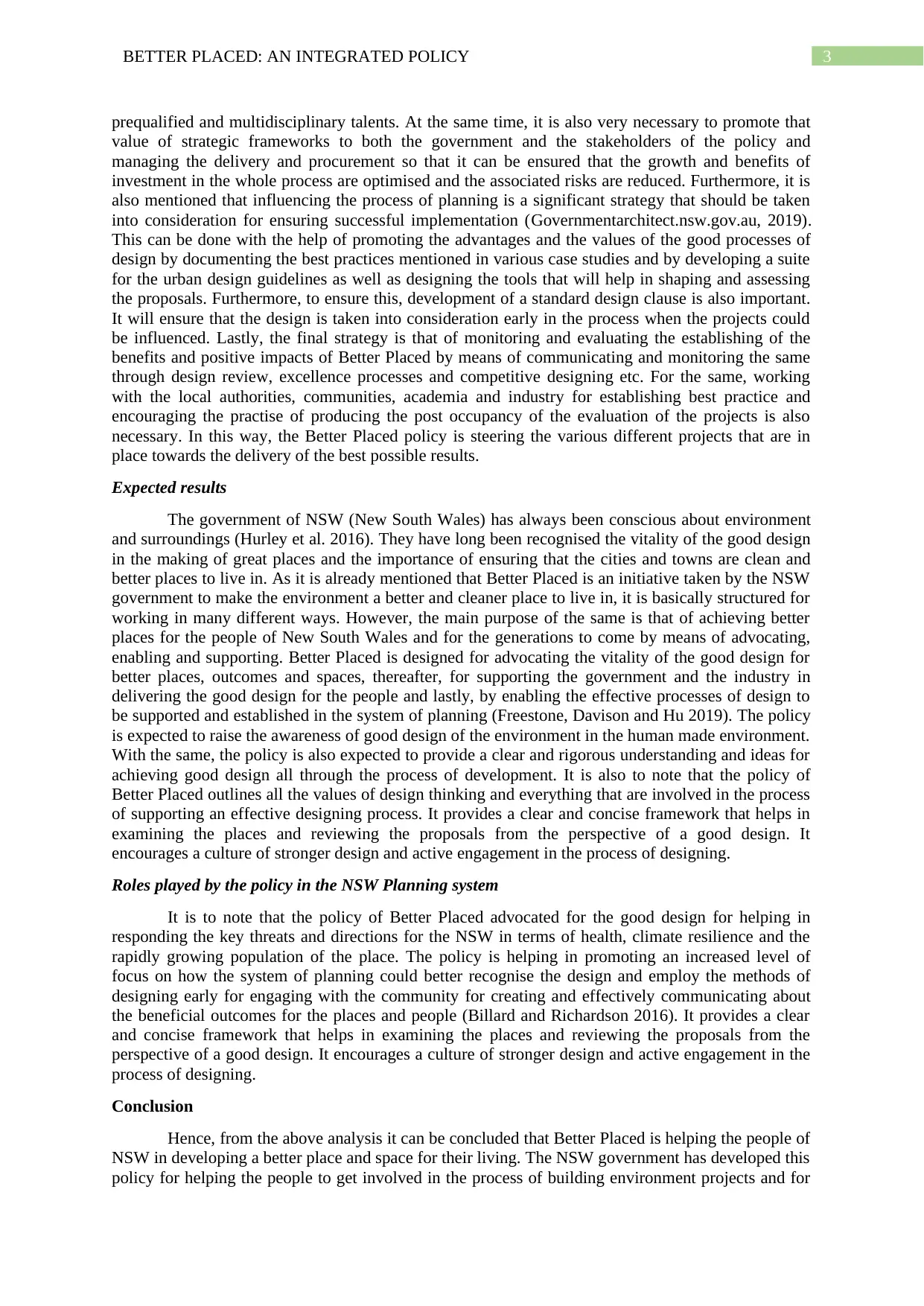
3BETTER PLACED: AN INTEGRATED POLICY
prequalified and multidisciplinary talents. At the same time, it is also very necessary to promote that
value of strategic frameworks to both the government and the stakeholders of the policy and
managing the delivery and procurement so that it can be ensured that the growth and benefits of
investment in the whole process are optimised and the associated risks are reduced. Furthermore, it is
also mentioned that influencing the process of planning is a significant strategy that should be taken
into consideration for ensuring successful implementation (Governmentarchitect.nsw.gov.au, 2019).
This can be done with the help of promoting the advantages and the values of the good processes of
design by documenting the best practices mentioned in various case studies and by developing a suite
for the urban design guidelines as well as designing the tools that will help in shaping and assessing
the proposals. Furthermore, to ensure this, development of a standard design clause is also important.
It will ensure that the design is taken into consideration early in the process when the projects could
be influenced. Lastly, the final strategy is that of monitoring and evaluating the establishing of the
benefits and positive impacts of Better Placed by means of communicating and monitoring the same
through design review, excellence processes and competitive designing etc. For the same, working
with the local authorities, communities, academia and industry for establishing best practice and
encouraging the practise of producing the post occupancy of the evaluation of the projects is also
necessary. In this way, the Better Placed policy is steering the various different projects that are in
place towards the delivery of the best possible results.
Expected results
The government of NSW (New South Wales) has always been conscious about environment
and surroundings (Hurley et al. 2016). They have long been recognised the vitality of the good design
in the making of great places and the importance of ensuring that the cities and towns are clean and
better places to live in. As it is already mentioned that Better Placed is an initiative taken by the NSW
government to make the environment a better and cleaner place to live in, it is basically structured for
working in many different ways. However, the main purpose of the same is that of achieving better
places for the people of New South Wales and for the generations to come by means of advocating,
enabling and supporting. Better Placed is designed for advocating the vitality of the good design for
better places, outcomes and spaces, thereafter, for supporting the government and the industry in
delivering the good design for the people and lastly, by enabling the effective processes of design to
be supported and established in the system of planning (Freestone, Davison and Hu 2019). The policy
is expected to raise the awareness of good design of the environment in the human made environment.
With the same, the policy is also expected to provide a clear and rigorous understanding and ideas for
achieving good design all through the process of development. It is also to note that the policy of
Better Placed outlines all the values of design thinking and everything that are involved in the process
of supporting an effective designing process. It provides a clear and concise framework that helps in
examining the places and reviewing the proposals from the perspective of a good design. It
encourages a culture of stronger design and active engagement in the process of designing.
Roles played by the policy in the NSW Planning system
It is to note that the policy of Better Placed advocated for the good design for helping in
responding the key threats and directions for the NSW in terms of health, climate resilience and the
rapidly growing population of the place. The policy is helping in promoting an increased level of
focus on how the system of planning could better recognise the design and employ the methods of
designing early for engaging with the community for creating and effectively communicating about
the beneficial outcomes for the places and people (Billard and Richardson 2016). It provides a clear
and concise framework that helps in examining the places and reviewing the proposals from the
perspective of a good design. It encourages a culture of stronger design and active engagement in the
process of designing.
Conclusion
Hence, from the above analysis it can be concluded that Better Placed is helping the people of
NSW in developing a better place and space for their living. The NSW government has developed this
policy for helping the people to get involved in the process of building environment projects and for
prequalified and multidisciplinary talents. At the same time, it is also very necessary to promote that
value of strategic frameworks to both the government and the stakeholders of the policy and
managing the delivery and procurement so that it can be ensured that the growth and benefits of
investment in the whole process are optimised and the associated risks are reduced. Furthermore, it is
also mentioned that influencing the process of planning is a significant strategy that should be taken
into consideration for ensuring successful implementation (Governmentarchitect.nsw.gov.au, 2019).
This can be done with the help of promoting the advantages and the values of the good processes of
design by documenting the best practices mentioned in various case studies and by developing a suite
for the urban design guidelines as well as designing the tools that will help in shaping and assessing
the proposals. Furthermore, to ensure this, development of a standard design clause is also important.
It will ensure that the design is taken into consideration early in the process when the projects could
be influenced. Lastly, the final strategy is that of monitoring and evaluating the establishing of the
benefits and positive impacts of Better Placed by means of communicating and monitoring the same
through design review, excellence processes and competitive designing etc. For the same, working
with the local authorities, communities, academia and industry for establishing best practice and
encouraging the practise of producing the post occupancy of the evaluation of the projects is also
necessary. In this way, the Better Placed policy is steering the various different projects that are in
place towards the delivery of the best possible results.
Expected results
The government of NSW (New South Wales) has always been conscious about environment
and surroundings (Hurley et al. 2016). They have long been recognised the vitality of the good design
in the making of great places and the importance of ensuring that the cities and towns are clean and
better places to live in. As it is already mentioned that Better Placed is an initiative taken by the NSW
government to make the environment a better and cleaner place to live in, it is basically structured for
working in many different ways. However, the main purpose of the same is that of achieving better
places for the people of New South Wales and for the generations to come by means of advocating,
enabling and supporting. Better Placed is designed for advocating the vitality of the good design for
better places, outcomes and spaces, thereafter, for supporting the government and the industry in
delivering the good design for the people and lastly, by enabling the effective processes of design to
be supported and established in the system of planning (Freestone, Davison and Hu 2019). The policy
is expected to raise the awareness of good design of the environment in the human made environment.
With the same, the policy is also expected to provide a clear and rigorous understanding and ideas for
achieving good design all through the process of development. It is also to note that the policy of
Better Placed outlines all the values of design thinking and everything that are involved in the process
of supporting an effective designing process. It provides a clear and concise framework that helps in
examining the places and reviewing the proposals from the perspective of a good design. It
encourages a culture of stronger design and active engagement in the process of designing.
Roles played by the policy in the NSW Planning system
It is to note that the policy of Better Placed advocated for the good design for helping in
responding the key threats and directions for the NSW in terms of health, climate resilience and the
rapidly growing population of the place. The policy is helping in promoting an increased level of
focus on how the system of planning could better recognise the design and employ the methods of
designing early for engaging with the community for creating and effectively communicating about
the beneficial outcomes for the places and people (Billard and Richardson 2016). It provides a clear
and concise framework that helps in examining the places and reviewing the proposals from the
perspective of a good design. It encourages a culture of stronger design and active engagement in the
process of designing.
Conclusion
Hence, from the above analysis it can be concluded that Better Placed is helping the people of
NSW in developing a better place and space for their living. The NSW government has developed this
policy for helping the people to get involved in the process of building environment projects and for
Secure Best Marks with AI Grader
Need help grading? Try our AI Grader for instant feedback on your assignments.
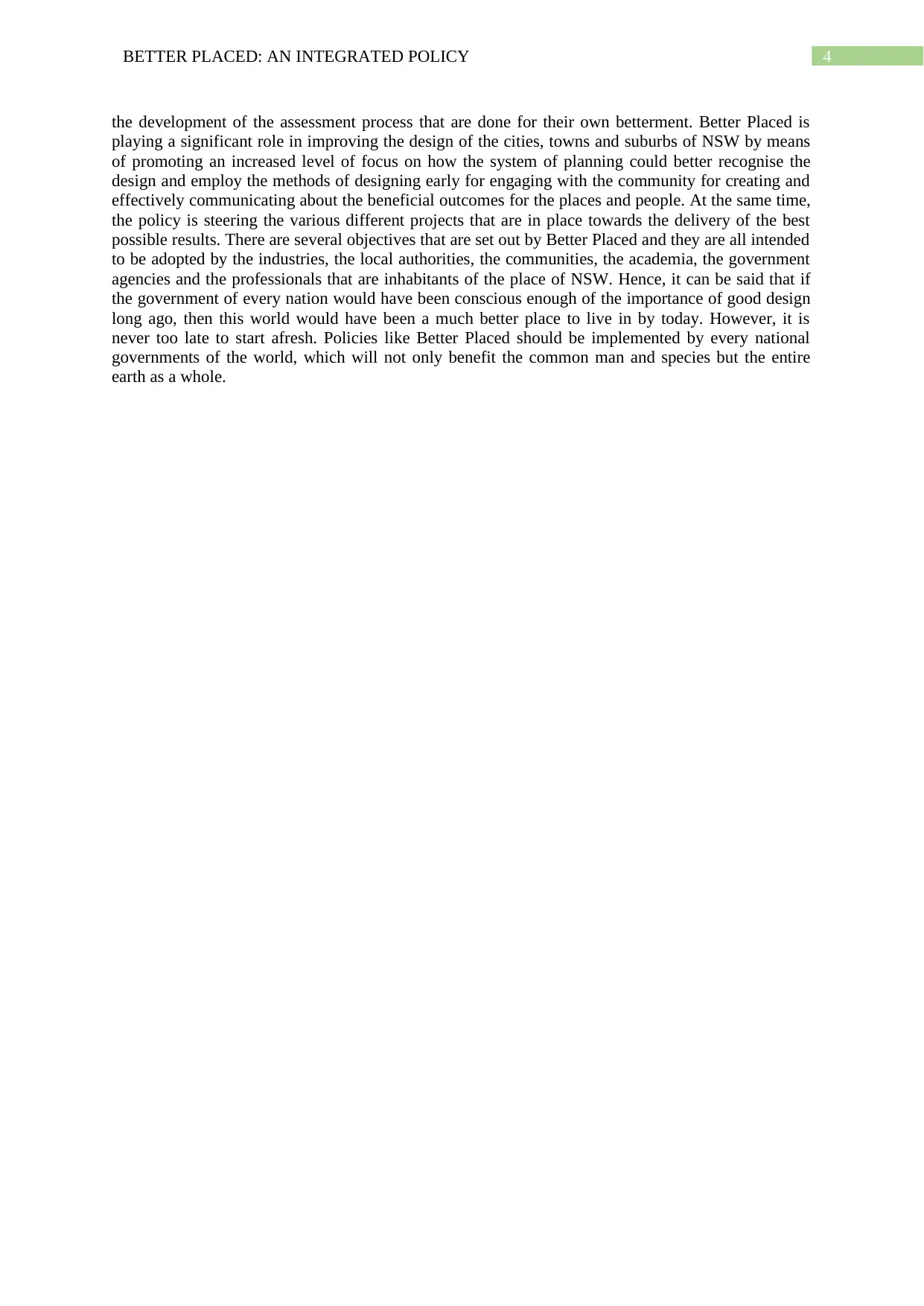
4BETTER PLACED: AN INTEGRATED POLICY
the development of the assessment process that are done for their own betterment. Better Placed is
playing a significant role in improving the design of the cities, towns and suburbs of NSW by means
of promoting an increased level of focus on how the system of planning could better recognise the
design and employ the methods of designing early for engaging with the community for creating and
effectively communicating about the beneficial outcomes for the places and people. At the same time,
the policy is steering the various different projects that are in place towards the delivery of the best
possible results. There are several objectives that are set out by Better Placed and they are all intended
to be adopted by the industries, the local authorities, the communities, the academia, the government
agencies and the professionals that are inhabitants of the place of NSW. Hence, it can be said that if
the government of every nation would have been conscious enough of the importance of good design
long ago, then this world would have been a much better place to live in by today. However, it is
never too late to start afresh. Policies like Better Placed should be implemented by every national
governments of the world, which will not only benefit the common man and species but the entire
earth as a whole.
the development of the assessment process that are done for their own betterment. Better Placed is
playing a significant role in improving the design of the cities, towns and suburbs of NSW by means
of promoting an increased level of focus on how the system of planning could better recognise the
design and employ the methods of designing early for engaging with the community for creating and
effectively communicating about the beneficial outcomes for the places and people. At the same time,
the policy is steering the various different projects that are in place towards the delivery of the best
possible results. There are several objectives that are set out by Better Placed and they are all intended
to be adopted by the industries, the local authorities, the communities, the academia, the government
agencies and the professionals that are inhabitants of the place of NSW. Hence, it can be said that if
the government of every nation would have been conscious enough of the importance of good design
long ago, then this world would have been a much better place to live in by today. However, it is
never too late to start afresh. Policies like Better Placed should be implemented by every national
governments of the world, which will not only benefit the common man and species but the entire
earth as a whole.
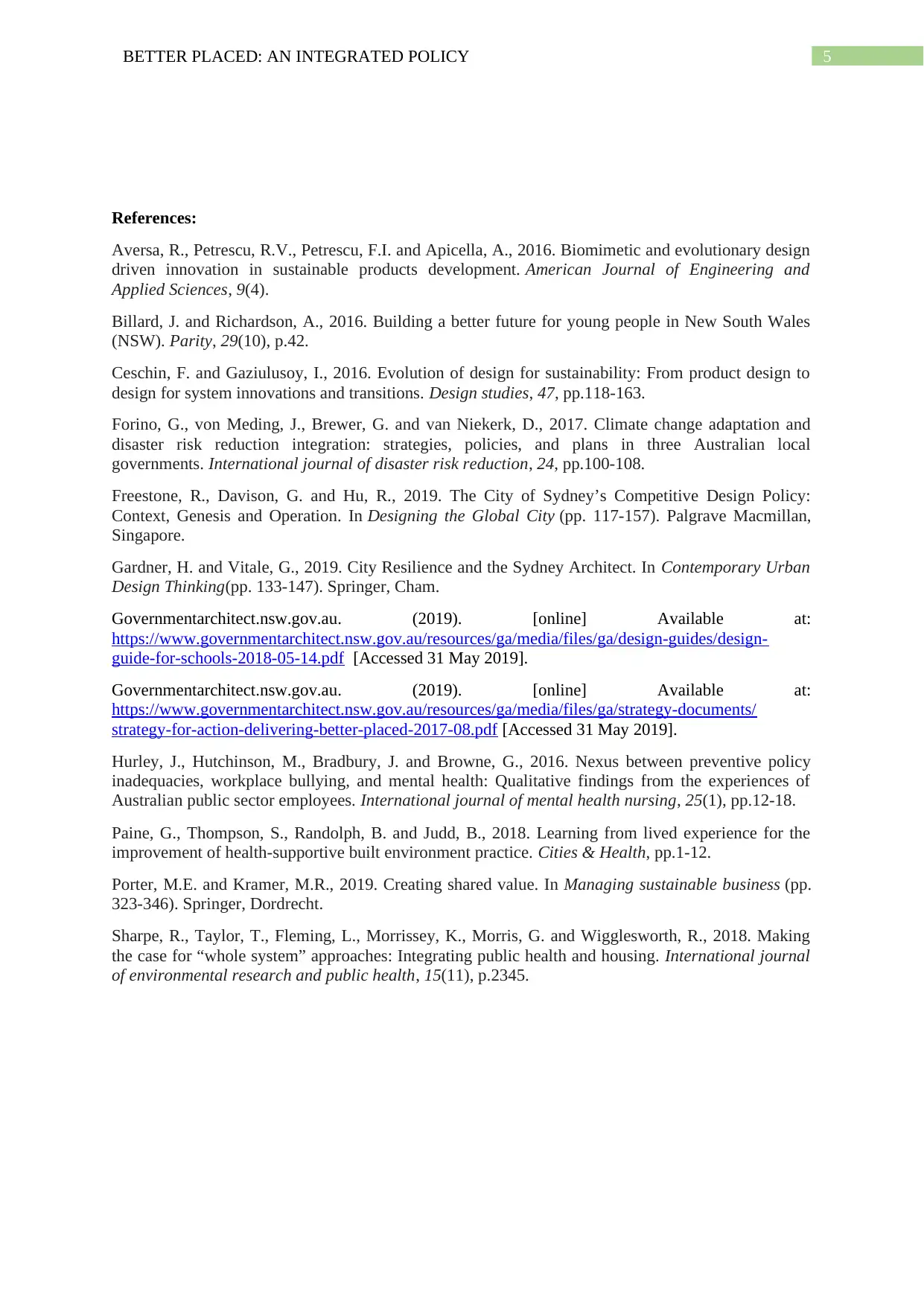
5BETTER PLACED: AN INTEGRATED POLICY
References:
Aversa, R., Petrescu, R.V., Petrescu, F.I. and Apicella, A., 2016. Biomimetic and evolutionary design
driven innovation in sustainable products development. American Journal of Engineering and
Applied Sciences, 9(4).
Billard, J. and Richardson, A., 2016. Building a better future for young people in New South Wales
(NSW). Parity, 29(10), p.42.
Ceschin, F. and Gaziulusoy, I., 2016. Evolution of design for sustainability: From product design to
design for system innovations and transitions. Design studies, 47, pp.118-163.
Forino, G., von Meding, J., Brewer, G. and van Niekerk, D., 2017. Climate change adaptation and
disaster risk reduction integration: strategies, policies, and plans in three Australian local
governments. International journal of disaster risk reduction, 24, pp.100-108.
Freestone, R., Davison, G. and Hu, R., 2019. The City of Sydney’s Competitive Design Policy:
Context, Genesis and Operation. In Designing the Global City (pp. 117-157). Palgrave Macmillan,
Singapore.
Gardner, H. and Vitale, G., 2019. City Resilience and the Sydney Architect. In Contemporary Urban
Design Thinking(pp. 133-147). Springer, Cham.
Governmentarchitect.nsw.gov.au. (2019). [online] Available at:
https://www.governmentarchitect.nsw.gov.au/resources/ga/media/files/ga/design-guides/design-
guide-for-schools-2018-05-14.pdf [Accessed 31 May 2019].
Governmentarchitect.nsw.gov.au. (2019). [online] Available at:
https://www.governmentarchitect.nsw.gov.au/resources/ga/media/files/ga/strategy-documents/
strategy-for-action-delivering-better-placed-2017-08.pdf [Accessed 31 May 2019].
Hurley, J., Hutchinson, M., Bradbury, J. and Browne, G., 2016. Nexus between preventive policy
inadequacies, workplace bullying, and mental health: Qualitative findings from the experiences of
Australian public sector employees. International journal of mental health nursing, 25(1), pp.12-18.
Paine, G., Thompson, S., Randolph, B. and Judd, B., 2018. Learning from lived experience for the
improvement of health-supportive built environment practice. Cities & Health, pp.1-12.
Porter, M.E. and Kramer, M.R., 2019. Creating shared value. In Managing sustainable business (pp.
323-346). Springer, Dordrecht.
Sharpe, R., Taylor, T., Fleming, L., Morrissey, K., Morris, G. and Wigglesworth, R., 2018. Making
the case for “whole system” approaches: Integrating public health and housing. International journal
of environmental research and public health, 15(11), p.2345.
References:
Aversa, R., Petrescu, R.V., Petrescu, F.I. and Apicella, A., 2016. Biomimetic and evolutionary design
driven innovation in sustainable products development. American Journal of Engineering and
Applied Sciences, 9(4).
Billard, J. and Richardson, A., 2016. Building a better future for young people in New South Wales
(NSW). Parity, 29(10), p.42.
Ceschin, F. and Gaziulusoy, I., 2016. Evolution of design for sustainability: From product design to
design for system innovations and transitions. Design studies, 47, pp.118-163.
Forino, G., von Meding, J., Brewer, G. and van Niekerk, D., 2017. Climate change adaptation and
disaster risk reduction integration: strategies, policies, and plans in three Australian local
governments. International journal of disaster risk reduction, 24, pp.100-108.
Freestone, R., Davison, G. and Hu, R., 2019. The City of Sydney’s Competitive Design Policy:
Context, Genesis and Operation. In Designing the Global City (pp. 117-157). Palgrave Macmillan,
Singapore.
Gardner, H. and Vitale, G., 2019. City Resilience and the Sydney Architect. In Contemporary Urban
Design Thinking(pp. 133-147). Springer, Cham.
Governmentarchitect.nsw.gov.au. (2019). [online] Available at:
https://www.governmentarchitect.nsw.gov.au/resources/ga/media/files/ga/design-guides/design-
guide-for-schools-2018-05-14.pdf [Accessed 31 May 2019].
Governmentarchitect.nsw.gov.au. (2019). [online] Available at:
https://www.governmentarchitect.nsw.gov.au/resources/ga/media/files/ga/strategy-documents/
strategy-for-action-delivering-better-placed-2017-08.pdf [Accessed 31 May 2019].
Hurley, J., Hutchinson, M., Bradbury, J. and Browne, G., 2016. Nexus between preventive policy
inadequacies, workplace bullying, and mental health: Qualitative findings from the experiences of
Australian public sector employees. International journal of mental health nursing, 25(1), pp.12-18.
Paine, G., Thompson, S., Randolph, B. and Judd, B., 2018. Learning from lived experience for the
improvement of health-supportive built environment practice. Cities & Health, pp.1-12.
Porter, M.E. and Kramer, M.R., 2019. Creating shared value. In Managing sustainable business (pp.
323-346). Springer, Dordrecht.
Sharpe, R., Taylor, T., Fleming, L., Morrissey, K., Morris, G. and Wigglesworth, R., 2018. Making
the case for “whole system” approaches: Integrating public health and housing. International journal
of environmental research and public health, 15(11), p.2345.
1 out of 6
Related Documents
Your All-in-One AI-Powered Toolkit for Academic Success.
+13062052269
info@desklib.com
Available 24*7 on WhatsApp / Email
![[object Object]](/_next/static/media/star-bottom.7253800d.svg)
Unlock your academic potential
© 2024 | Zucol Services PVT LTD | All rights reserved.





